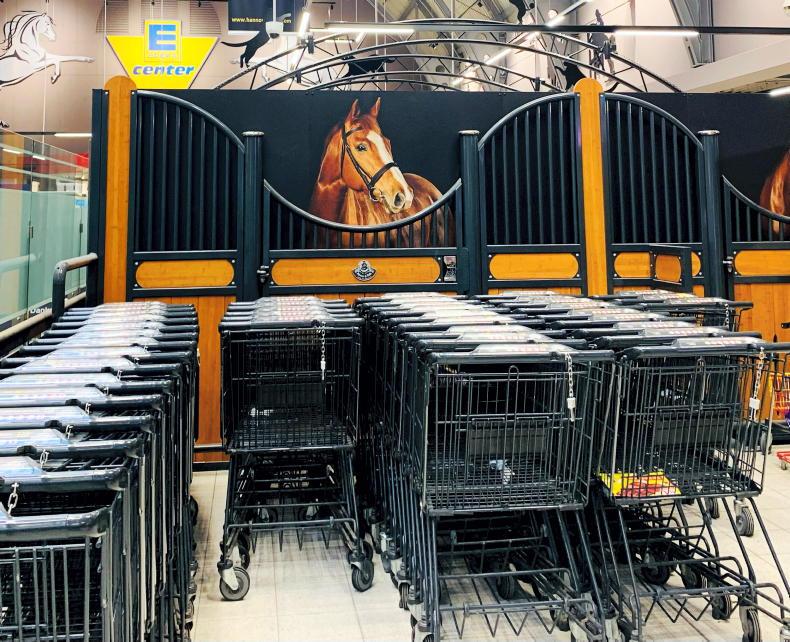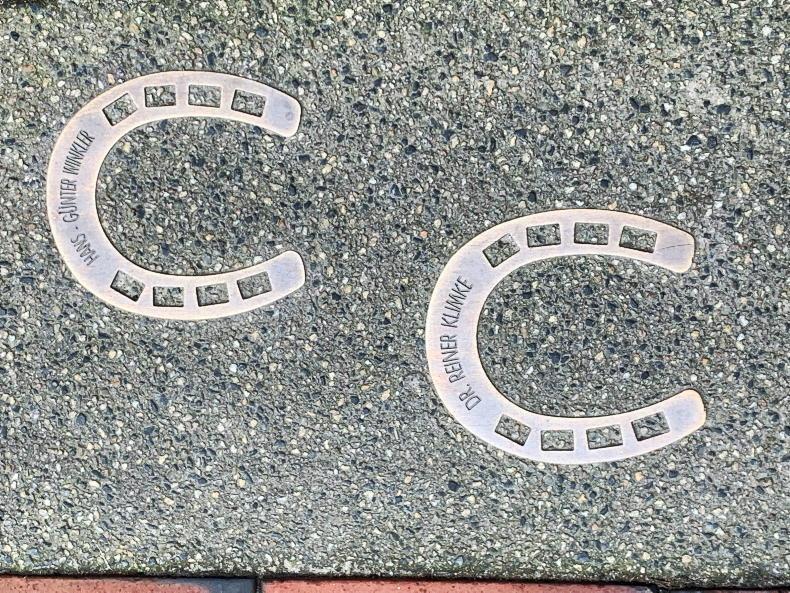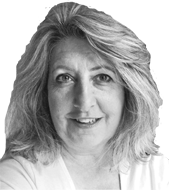THE Bluegrass State’s Lexington claims to be the ‘Horse capital of the world.’ Scone is, not as the New South Wales town’s name suggests the centre for afternoon teas, but is billed as Australia’s horse capital.
Here in the ‘Land of the Horse’, there’s the Irish Horse Museum at the Irish National Stud and Fethard’s Horse Country Experience.
What about Germany, the land of equestrian medalists? Verden, or ‘Reiderstadt’ - that’s Germany’s equestrian capital. ‘Rider City’ not only doubles as the Hanoverian Verband base and home of the world-famous Verden sport horse auctions but is the location of the Deutsches Pferdemuseum.
Locating Verden and the museum itself is simple, thanks to the sublime German public transport system with easy connections from both Bremen and Hamburg airports.
En-route to Verden, Northern Germany’s landscape is very different from the hilly Black Forest or Bavarian regions. Up here, flat fields sprout wind turbines and row after row of solar heating panels as well as more traditional crops.
The region’s heavy, clay soil also shaped the type of previous generations of Hanoverian horses required for farmwork and transport. That was before motors and railways replaced horsepower. And after the European cavalry era was thankfully replaced too.
A classic case of recycling, part of Verden’s former Holzmarkt Kaserne cavalry barracks was converted into the current home of the Pferdemuseum.
The east wing of the red brick complex is visible from the railway station, another throwback to German efficiency when barracks and transport systems were designed side-by-side. And as you round the corner at the end of the street, the museum, with the famous Tempelhüter statue guarding its entrance, comes into sight.
The power of paintings and photographs show what Holzmarkt Kaserne looked like back in previous centuries. Built around 1829 to house the Verden Hussars and Duke of Cumberland’s Hussars, its red brick buildings still form three sides around a central courtyard.
There are strong British links to this region with strategic ties between the British and Hannoverian royal households. The early 19th century Duke of Cumberland was a son of King George III and later became King of Hannover, while post-WWII, Verden became one of several British garrisons within Germany.
After several barracks around the city were handed back, the Holzmarkt Kaserne first became a base for an artillery regiment. Then in 1987, the building was once again handed over, this time as the town’s horse museum.
“Horsey Pope”
The concept of Verden having a home for a collection of horsey artefacts gathered by locals, goes back a century ago. Wilhelm Ahrens and Erich Clausen were the original champions for a museum devoted to the history of the horse in Germany.
However, progress stalled as “during the war years other things were more important for the population,” a matter-of-fact understatement included in the museum’s background guide.
By 1965, it was all systems go when the Deutsche Pferdemuseum was formally established in two historical buildings elsewhere within the city.
Another driving force emerged in Hans Joachim Köhler, known reverentially in these parts as the ‘Horsey Pope.” Author and founder of the Verden auctions, Köhler established the Museum’s massive library collection, now housed at the ‘Holzmarkt’ when the museum was eventually combined under one roof in 2000.
“Verden has a long tradition as a horse town, especially due to the Hannoverian Verband which is located here and also because of the variety of horse shows,” said the Musuem’s über-helpful Ina Rohlfing.
“The museum has around 18,000 visitors per year. For sure, a lot of guests are tourists staying in Verden for horse events but we also have programmes for school classes and horse and pony clubs, which are well frequented.”
One popular temporary exhibition is the European Wildlife Photographer of the Year 2022 exhibition with its stunning gallery of prizewinning photographs. Located in a gallery to the left of the entrance lobby, the exhibition had attracted a steady stream of visitors that morning eager to see it before it ended last Sunday.
“It’s organised annually by the German society for nature photography and every winter for the past nine years, we have been showing the latest competition results. Then, from June to October 2023, we show an exhibition about the prehistoric horse and its habitat 55 million years ago.”
A sequence of models of prehistoric horses over a 50 million year timespan and a lifelike Przewalski’s horse are amongst the first sights on a self-guided tour, which starts past the gift and bookshop.
From there, it’s two floors of exhibits and story panels, following the history of horses in Germany and their changing job roles, from medieval chargers to farm work and transport to Olympic gold medal winners.
Primitive bits, spurs, harnesses and race saddles evolve along rows of display cases, plus some jaw-dropping early veterinary and horse dentistry implements.
Ploughing, driving, cavalry, racing, hunting, vaulting and all three Olympic sports are further parts of the story.
The ground floor was once filled with stalls and the original mangers and water troughs still line the perimeter walls. There are more clues to the building’s original purpose: a bridle rack, tie rings, an early automatic feeder system with its chute leading up to the top floors where grain and hay were stored overhead.
Powerful photos
All of the information panels contents are in German. Smartphone to the rescue again, although, with the power of photographs, there is often no need for a translator app.
Clever features include sets of binocular lenses set into a wall (look through them to see various scenes such as a stablehand grooming a horse with a jumbo-size currycomb) and a row of pull-out ‘larders’, each containing information on German studbooks, old photographs and trophies.
One informative map, dated 2000, pinpoints and illustrates various German breeds and their studbook emblems: Holsteiner and Chacco-Blue’s Mecklenburg zones to the north and north-east of Hannover; Oldenburg directly to the west, Berlin-Brandenburg to the east and further south, several regions now incorporated into the Deutsches Sportpferd studbook, such as Baden-Württemberg.
Peals of laughter ring through one room as a family clamber up steps onto a carriage to literally take up the reins. Facing a video screen, with a drivers seat view of the hindquarters and heads of two high-stepping horses, the goal is to ‘drive’ this pair around country roads.
Two more interactive features and novel opportunities for urban visitors to try out a new hobby are via mechanical horses, one tacked up with a side-saddle.
Some of the most powerful photos throughout the museum include black & white shots from the 1930s: a row of stablehands and cavalry soldiers on stalldienst (stable duty) and a member of the cavalry remount buying commission in some Oldenburg market square, placing a measuring stick on a fine-looking, albeit dock-tailed, four-legged potential recruit.
Or an indoor arena with a derby style-course laid out in front of a near-full house of spectators.
Looking closely at this photo taken in 1936 at the “internationalen Deutschenhallenturnier” - most likely Berlin? - swastika banners are amongst the flags draped around the upper level.
This was one of the reasons I liked the museum. No revised history or selective memories. These are zeitgeist stories and pictures. This tell-it-as-it-was informative approach is carried through again on a timeframe display running from the First World War to the London Olympics.
Again, powerful images include the sight of a German cavalry soldier seated on his dock-tailed horse on a razed battleground with a biplane passing overhead, through the era of the omnipotent Halla and Hans Günther Winkler, right up to a beaming Michael Jung and Sam with their Olympic gold medals at London.
Another retro photo is of the 1982 world show jumping champion Norbert Koof and Fire 2 at Dublin.
Running parallel underneath on each red display panel is a timeline of world events. Again there’s no airbrushing. A photo of the Auchwitz-Birkenau concentration camp is placed beside an aerial view of a near-flattened Dresden, targeted by RAF and USAF bombing missions towards the end of WWII, (intended to mirror the Luftwaffe campaigns that razed parts of London and other British cities during the Blitz).
The Brandenburg Gate is obscured by rolls of barbed wire, another photo is of New York’s Twin Towers on fire and followed by landmark events in German and European history this millennium, such as the election of the late Pope Benedict XVI in 2005, the rise of Angela Merkel and the introduction of the euro.
Various screens around the museum feature interviews with equestrian sport patron Madeleine Winter-Schulz, Hans Günther Winkler, Ingrid Klimke and Michael Jung and a whimsical black-and-white film about the ‘lost paradise’ of the Trakehner state stud in Prussia.
Amongst secondhand titles on sale in the bookshop are vintage L’Annee Hippique volumes and Irland’s Pferd, a 1970s travel book. Another book - Sibylle Luise Binder’s Die Flucht Der Trakehner - tells of the hasty evacuation of the Trakehner State Stud in the face of the approaching Red Army and the notorious conditions endured en-route west.
The last surviving Trakehner from that gruelling march was the chesnut stallion Keith. Of 56,000 Trakehners in East Prussia in 1944, less than 1,000 made it to the west.
There was not much of a welcome for the refugees and their horses with severe food and housing shortages amongst already overstretched locals. Especially when it became compulsory for families to move into one bedroom and give up their remaining sleeping quarters for the refugee arrivals.
Nor were the Trakehner horses welcomed either, viewed by local farmers as almost too fanciful to cope with working the heavy clay soil.
On a happier note, there were few dry eyes amongst those gathered when Keith, this grand old citizen, was present as a special guest of honour when his famous grand-sire Tempelhüter’s statue was unveiled in Verden.
Again, it was through the efforts of Hans-Joachim Köhler, that this replica was created. The original statue, which stood at the Trakehnen State Stud, was amongst the war booty taken back to Russia, along with any horses remaining at the Trakehnen state stud.
Tempelhüter’s statue may be a replica but its home Verden is a real gem to visit.
A ‘HORSE SUPERMARKET’ AND HORSESHOE-LINED COBBLED STREETS
“VERDEN has a long tradition as a horse town – especially due to the Hannoverian Verband which is located here and also because of the variety of horse shows,” Ina Rohlfing of the Verden pferdemuseum explained.
“The horse therefore appears again and again in the cityscape. For example, the two foal statues in the town centre, Tempelhüter´s statue in front of the museum, the statue of the mare Dieta with her foal in front of the Hanoverian Verband… and you will find bronze horseshoes embedded in the ground, showing the way from city centre to the horse museum.”
It’s time to take a look around Verden. The statue of Tempelhüter, considered the perfect example of a Trakehner horse, is the first sight ticked off. The replica takes pride of place outside the Museum, where its brick walls are still lined with rows of original tie rings for long-gone horses.
A bistro, theatre and Edeka - similar to our Supervalu chain - supermarket fill the other buildings and the place bustles with Friday morning shoppers.
Germany has one of Europe’s highest rates of dog ownership. One four-legged member of its estimated 10 million canine population is tethered handily to an old horseshoe embedded in the wall outside Edeka while its owner goes shopping.
The supermarket interior is a surprise. Or maybe not for a horse town. Shopping trollies are ‘stabled’ in a Loddon-style bay, its cosy coffeeshop walls are covered in equine prints and Hannoveraner Verband and show jumping scene banners dangle from the ceilings.

Beside the coffeeshop, bookworms can take away donated books left on a bookcase. Amongst the titles is a copy of Nicholas Evans’ Der Pferde-flüsterer. Free wifi and Google Translate confirm it is indeed The Horse Whisperer.
Next it’s follow the bronze horseshoe trail, with names of German equestrian greats and sponsors, to the ‘Aldstadt’ or old part of the city with its cobbled streets, lemon-coloured town hall and half-timbered houses straight out of a Grimm Brothers storybook illustration.
Not surprisingly, this part of Saxony along the flat banks of the Aller river is on the Grimm Brothers driving/cycling route, as is the Weser-Radweg. “A very popular bike trail passing the city of Verden. Most of our guests are tourists visiting the city by bike,” Ina added.
‘Bike & Bett’ (Bike & Bed) signs are a familiar sight at Verden’s accommodation premises, which range from family hotels to stunning Air BnB gems. It’s interesting, faced with the same energy price hikes and staff shortages as their Irish counterparts, how competitive Germany’s accommodation prices are.
The foal statues are the final find on the charming main street, lined with lots of family businesses and the Friday market. Unlike the UK and Ireland, there’s no shortage of tomatoes or cucumbers on the vegetable stalls lining the street where an alleyway brings you to the city’s Domherrenhaus history museum, housed in an old medieval house with delightfully crooked walls and wavy floors.
Verden’s museums are well worth a visit, not only for their own historical content but as a sombre reminder of how history repeats itself.
The Horse Museum’s battlefield and bombed-out city photos are reminiscent of scenes from both All Quiet On The Western Front (the German film strongly tipped for tomorrow night’s Oscars) and daily TV reports from shelled Ukranian cities.

The Domherrenhaus museum refers to the Marshall Plan, (a US loan scheme to rebuild post-war Germany), which raises the question of who pays to rebuild the Ukraine too?
Just this week, news headlines were dominated by the Irish housing crisis, Gary Lineker’s comments in comparing Great Britain’s plans to clamp down on migrants crossing the English Channel to policies in 1930s Germany and ambitious plans to increase the use of public transport by introducing increased parking fees and introducing congestion charges. Something that will only really work when Ireland can match Germany’s superb system? Questions and answers.
By the numbers
27,000 - Verden’s population.
18,000 - visitors to the Deutsches Pferdemuseum each year.
18,000 x 2 - books, videos and archive items in the museum’s reading room and research library.
865 - German cavalry horses lost each day during WWII from “wounds, starvation, cold and illness,” mainly on the Eastern Front.
500 - bronze horseshoes set into the streets of Verden, linking the Pferdemuseum to the main street.
6 - British monarchs were members of the German House of Hanover, including the last in line, Queen Victoria.
5 - euros worth-every-cent admission price to the Deutsches Pferdemuseum.
Next week: The Hannoveraner Verband.


 This is a subscriber-only article
This is a subscriber-only article
 It looks like you're browsing in private mode
It looks like you're browsing in private mode








SHARING OPTIONS: